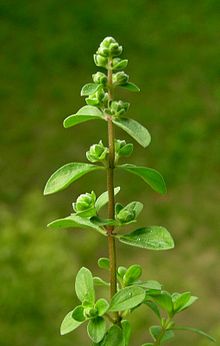 |
|
|
|
|
| Cuisines | Herbal | Spice | Curry | Yeast | Recipe | ||||||
|
Marjoram Marjoram (Origanum majorana, syn. Majorana hortensis Moench, Majorana majorana (L.) H. Karst[2]) is a somewhat cold-sensitive perennial herb or undershrub with sweet pine and citrus flavors. In some Middle-eastern countries, marjoram is synonymous with oregano, and there the names sweet marjoram and knotted marjoram are used to distinguish it from other plants of the genus Origanum. The name marjoram (Old French majorane, Medieval Latin majorana) does not directly derive from the Latin word maior (major).[3] Marjoram is indigenous to the Mediterranean area, and was known to the Greeks and Romans as a symbol of happiness. CultivationConsidered a tender perennial (USDA Zones 7-9), [4] marjoram can sometimes prove hardy even in zone 5. Marjoram is cultivated for its aromatic leaves, either green or dry, for culinary purposes; the tops are cut as the plants begin to flower and are dried slowly in the shade. It is often used in herb combinations such as herbes de Provence and za'atar. The flowering leaves and tops of marjoram are steam-distilled to produce an essential oil that is yellowish in color (darkening to brown as it ages). It has many chemical components, some of which are borneol, camphor and pinene. Related species Oregano (Origanum vulgare, sometimes listed with marjoram as Origanum majorana) is also called wild marjoram. It is a perennial common in southern Europe in dry copses and on hedge-banks, with many stout stems 30–80 cm high, bearing short-stalked, somewhat ovate leaves and clusters of purple flowers. It has a stronger flavor than marjoram. Pot marjoram or Cretan oregano (Origanum onites) has similar uses to marjoram. Hardy marjoram or French marjoram, a cross of marjoram with oregano, is much more resistant to cold, but is slightly less sweet. Origanum pulchellum is known as showy marjoram or showy oregano. |











